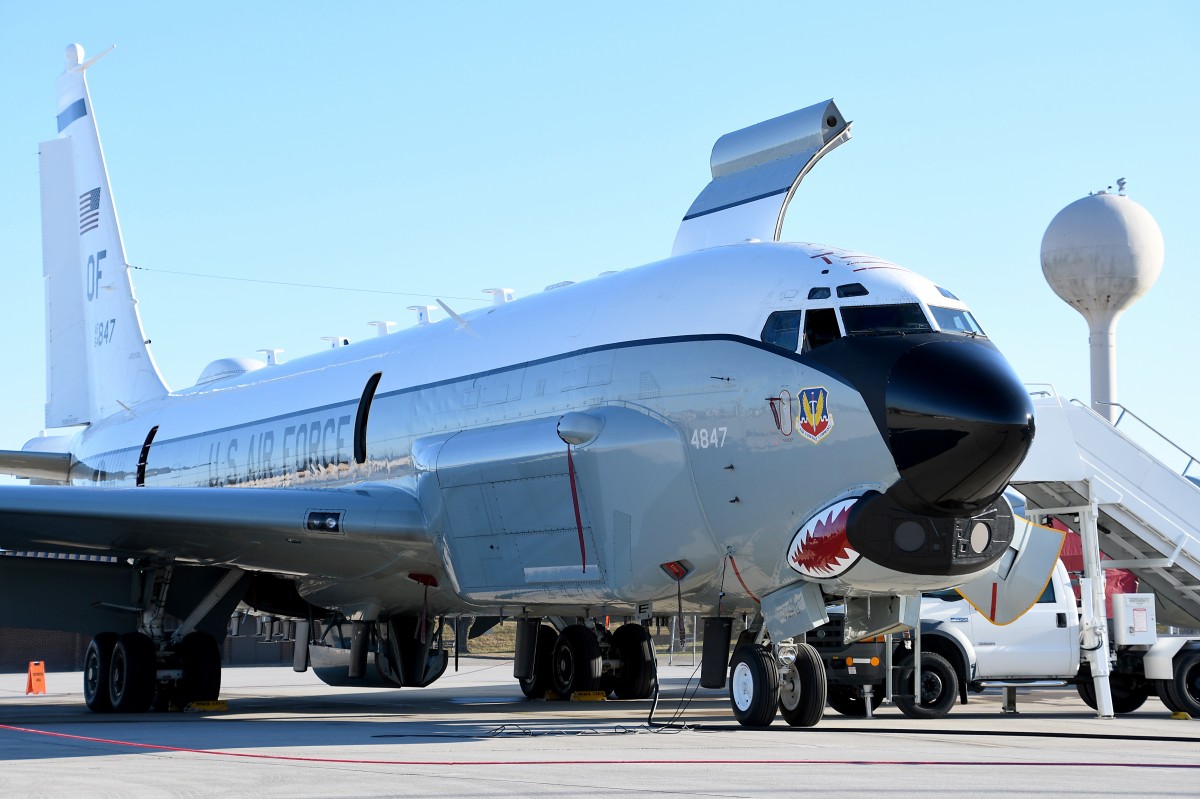Over the past week, amidst the already simmering tension between China and the US, a United States Air Force electronic intelligence aircraft has been conducting surveillance missions along the Chinese coastline.
Flight-tracking data shared by Hans M. Kristensen, Director of the Nuclear Information Project at the Federation of American Scientists, revealed the movements of the American spy plane, registered with the serial number 6414847, as it conducted sweeps along strategic coastal areas of China.
These operations, undertaken from the Kadena Air Base on the Japanese island of Okinawa, occurred on May 7, 9, 10, and 13. According to Kristensen, the RC-135U embarked on multiple long-endurance flights, varying its routes each time.
On May 7, the aircraft completed an eight-hour flight, transiting the Luzon Strait north of the Philippines before circling the China-controlled Paracel Islands in the South China Sea and loitering around the Pearl River Delta.
Over the past week, RC-135U Combat Sent (6414847) has been doing sweeps along Chinese coastline: 3 northeast and 1 south.
It collects electronic data to locate/identify radar signals to determine detailed operating characteristics and capabilities. https://t.co/Hu6haF0dtq pic.twitter.com/bcybR0hopZ
— Hans Kristensen (@nukestrat) May 13, 2024
Subsequent flights on May 9 and 10, each lasting six hours, saw the Combat Sent flying north through the East China Sea, reaching the Yellow Sea off northeastern China.
On May 13, the aircraft circled near Shanghai before redirecting towards Taipei, then altering its course to proceed north through the East China Sea, ultimately reaching the Yellow Sea near Shandong before returning to base.
The areas scanned by the RC-135U Combat Sent on May 9, 10, and 13 were near Shanghai, where China’s maritime safety authority had declared a no-go zone for the aircraft carrier Fujian’s sea trials from May 1 to 9.
The US Defense Department has not disclosed the specific nature of these operations. These surveillance sorties emerged against escalating tensions between China and Western nations.
Recently, Australia accused a Chinese fighter jet of firing flares into the path of an Australian Seahawk helicopter over international waters of the Yellow Sea. Australian Prime Minister Anthony Albanese condemned the act as “completely unacceptable.”
In response, China’s foreign ministry accused the Australian Navy helicopter of provocative actions near Chinese airspace. Further, on May 10, the Chinese military announced the expulsion of the US guided-missile destroyer USS Halsey, alleging it had trespassed into Chinese territorial waters off the Xisha Islands in the South China Sea.
RC-135U Combat Sent Aircraft
The recent surveillance activities of the US Air Force’s RC-135U Combat Sent intelligence-collection aircraft along the Chinese coastline highlight the specialized nature of these platforms in collecting electronic intelligence.
Distinguished by its distinctive antennas on the underside of its front fuselage, tail cone, and wingtips, the Combat Sent is configured to gather a wide array of signals and electronic intelligence crucial for national-level technical requirements.
Unlike the larger RC-135V/W Rivet Joints, which possess similar capabilities, the RC-135Us primarily focus on supporting national-level technical electronic intelligence (TechELINT) requirements.
Technical ELINT involves analyzing signal structures, emission characteristics, modes of operation, and emitter functions of various sources such as radars, beacons, jammers, and navigational signals.
This information helps define the capabilities and roles of emitters within large systems, facilitating the design of radar detection, countermeasures, or counterweapons — a crucial aspect of electronic warfare.
Geolocating and categorizing radars and other signal emitters are vital for producing accurate “electronic orders of battle,” especially regarding adversaries’ air defense capabilities.

The RC-135Us are equipped to process intelligence data onboard and transmit information in near-real-time. They play a pivotal role in gathering such intelligence.
The recent flight routes of the RC-135U suggest a focus on China’s coastlines, where a plethora of radars and signal emitters of interest are located. These reconnaissance efforts generate comprehensive assessments of adversaries’ capabilities and intentions.
Nonetheless, the RC-135U is just one among several crewed and uncrewed US aircraft conducting regular reconnaissance in the East and South China seas.
While these patrols often occur near Chinese shores, they strictly adhere to international airspace regulations, according to reports from a Beijing-based think-tank, the South China Sea Strategic Situation Probing Initiative (SCSPI).
Recent statistics indicate a significant uptick in US spy flights in the region over the past four years, reaching at least 1,000 sorties annually, as previously reported by the EurAsian Times.
Despite the US asserting its rights to operate in international airspace, China has consistently voiced concerns over American aircraft and vessels operating in proximity to its territory.
- Contact the author at ashishmichel(at)gmail.com
- Follow EurAsian Times on Google News





